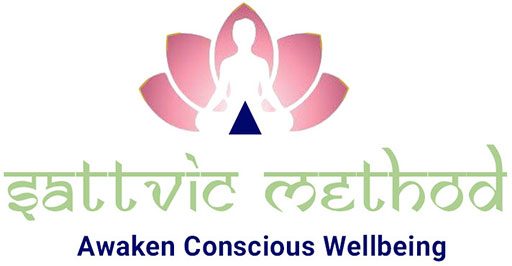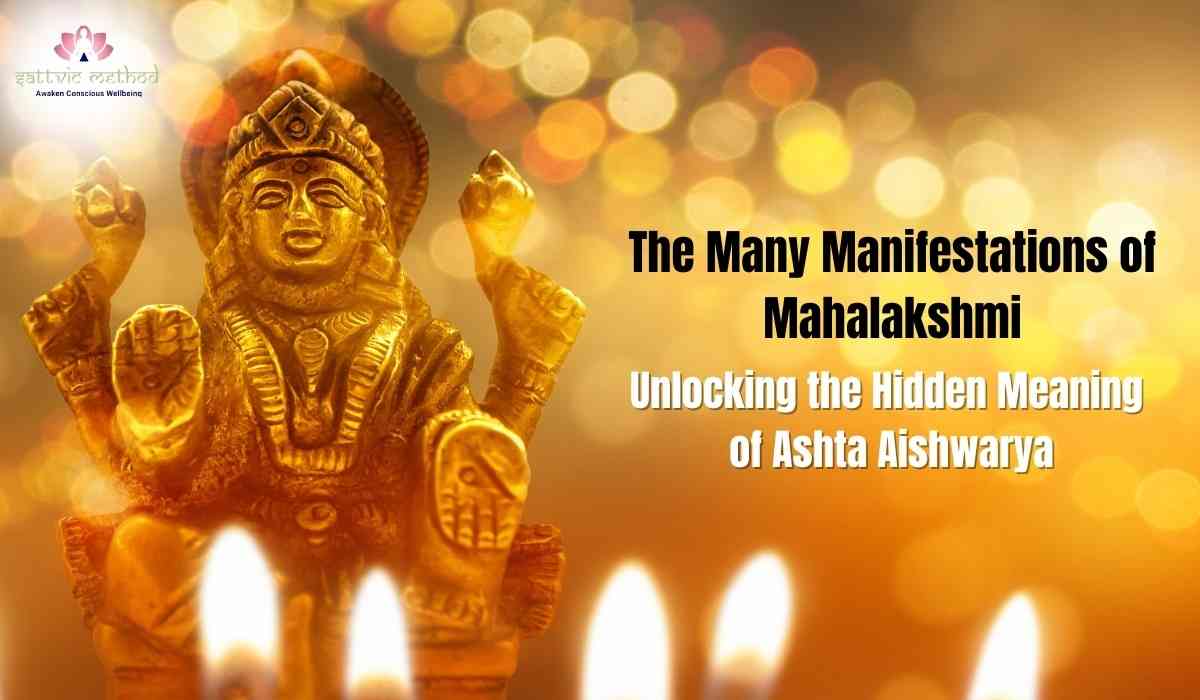The Many Manifestations of Mahalakshmi: Unlocking the Hidden Meaning of Ashta Aishwarya
लक्ष्मींक्षीरसमुद्रराजतनयांश्रीरङ्गधामेश्वरीं
दासीभूतसमस्तदेववनितांलोकैकदीपाङ्कुराम् ।
श्रीमन्मन्दकटाक्षलब्धविभवब्रह्मेन्द्रगङ्गाधरां
त्वांत्रैलोक्यकुटुम्बिनींसरसिजांवन्देमुकुन्दप्रियाम् ॥
lakshmeem ksheera samudra-raaja thanayaam shree rangadhaamesvareem
daseebhuutha samastha deva vanithaam lokaika deepaamkuraam |
shree manmanda kataaksha labda vibhava brahmendra gangaadharaam thvaam thrilokya kutumbineem sarasijaam vande mukunda prayaaam ||
I pray to thee O goddess Laxmi, born out of a (large) lake, daughter of the lord of the ocean, mistress of the house of Vishnu (the one who loves her), the one (in front of whom) all other wives of gods are like lowly servants, unique illuminator of the worlds, by whose passing glance (alone) the gods Brahma, Indra and Shiva (holding Ganga) obtained their riches, the matriarch of the three worlds, and the beloved of Mukund (Vishnu).
When we speak of Mahalakshmi, we do not merely evoke the image of a golden goddess sitting on a lotus, surrounded by elephants and coins. That imagery, while sacred, is only a veil; beneath it lies the vast, unfathomable truth of Shakti herself. She is Chit-Shakti, the creative, nourishing, protective force of the cosmos, who appears again and again, not only in temples or shlokas, but in every breath of prosperity, peace, and progress.
To truly understand her, we must look beyond just the surface icons and go deep into the Ashta Aishwarya, the eight divine forms of wealth. These are not random blessings. They are precise, spiritually coded aspects of life, each of which corresponds to a distinct manifestation of Mahalakshmi, her sacred leelas, her tattvas, her presence in our worldly and spiritual existence.
Let us journey into each form of Aishwarya, and see how Sri Mahalakshmi reveals herself in that experience, not as a mere bestower of gifts, but as the very pulse of life itself.
Dhanam – Cash and Gold: The Radiance of Dhana Lakshmi
The first and most commonly understood form of wealth is Dhanam, material assets, cash, and gold. But to see it as mere money is to miss the spiritual richness Mahalakshmi infuses into it.
Dhana Lakshmi is not just the goddess who fills coffers. She is the rasa of abundance, the dharmic flow of Artha in the Purushartha Chatushtaya. When wealth is earned righteously, without greed or deceit, when it circulates with generosity and not hoarding, then she is truly present.
In the Lakshmi Tantra, she is described as the one who “makes the heart of even the most indifferent melt with compassion through the glint of righteous riches.” Her wealth is sacred, and to misuse it is to insult the Devi herself. When gold is worshipped not for power but for seva, when transactions are done with fairness, Mahalakshmi resides there.
Dhanyam – Paddy and Nourishment: The Sacred Harvest of Dhanya Lakshmi
Dhanyam refers not just to food, but to the very ability to sustain life. It is the paddy in the granary, the roti on the plate, the mango on the tree. In this sacred form, Mahalakshmi manifests as Dhanya Lakshmi—she who nurtures the world with annam, the sacred food which even the Vedas declare as Brahman.
The prayer to Mahalakshmi Parasakti, as the sustainer of life, is Annapurneswari
Annapurnesadapurne, Shankara prana vallabhe
Gyaanavairagyasiddhyarthambhikshaamdehi cha parvati”.
She is the spirit behind Annapurna, the goddess of food and nourishment. Without her, there is famine not only of the body but of the spirit. When grains grow, when the kitchen smells of fresh rice, when no one sleeps hungry in a village, Dhanya Lakshmi smiles.
Her presence teaches us that wealth means nothing if the stomach is empty. To feed is to worship her; to waste is to drive her away.
Santhanam – Children and Legacy: The Gentle Grace of Santana Lakshmi
To have children is not merely a biological act; it is a continuation of Dharma, of culture, of memory, and of divine energy. Santhanam, or progeny, is considered one of the most sacred forms of wealth in the Sanatana tradition. In this sphere, Mahalakshmi reveals herself as Santana Lakshmi, the mother who blesses not only fertility but the strength of family and lineage.
In the Sri Suktam, we find:
“Putra Pautra dhanam dhanyam hasta bhushanameva cha
Deyam me devi santanamshigramevadayanidhe”
She does not simply give children, she gives virtuous children, those who will carry forward the name of the ancestors, who will protect dharma, who will serve society.
But her blessing also extends beyond physical birth. Creativity, legacy, continuation of traditions, and the ability to leave behind a meaningful imprint on the world, these too are her domain. A life that echoes beyond the body, into future generations, is a temple where Santana Lakshmi resides.
Jaya – Victory and Success: The Triumph of Vijaya Lakshmi
In every endeavor of life, be it spiritual Sadhana, worldly enterprise, or familial responsibility, the seeker desires success. But victory is not merely the outcome of competition. It is the fulfillment of one’s Prarabdhakarma, the fruit of one’s tapas.
Here enters Vijaya Lakshmi, the manifestation of Mahalakshmi, who ensures that righteousness prevails. Her name itself means victory. She is praised as:
“Jaya Lakshmi Namastestu, MahashaktiSwarupini
Yashasvinim Vibhutim Cha Pradayanti Namostute.”
Vijaya Lakshmi is not the goddess of reckless conquest but of victory aligned with dharma. She was with Rama when he conquered Ravana, with Arjuna in Kurukshetra, with every saint who overcame their inner demons.
When the seeker rises from failure, when truth prevails despite all odds, it is Vijaya Lakshmi who has touched that moment.
Dhairya – Courage and Determination: The Fire of Veera Lakshmi
Courage is the most underestimated wealth. Without Dhairya, no other Aishwarya can be manifested. This is the wealth of inner steel, of the will to persevere, of the refusal to bow to fear.
Mahalakshmi takes on the form of Veera Lakshmi when she enters the hearts of warriors, seekers, mothers, and mendicants, anyone who must walk the path of truth against resistance.
The Devi Mahatmyam says:
“Yuddha priyamyuddhavisharadaam cha
Veera Lakshmimvaradamsharanamprapadye”
She is the one who stood by Durga in battle, the one who gave Bhishma his fearlessness, the one who burns in the eyes of those who protect dharma at any cost. This is not aggressive rage, it is shakti, composed and purposeful, wielded with sacred intention.
Ayudha Bala – Weaponry and Strategy: The Intelligence of Ayudha Lakshmi
Ayudha Bala, or weaponry, is symbolic not only of defense but also of strategic acumen, mental clarity, and the ability to act decisively in complex situations. In the modern world, this is akin to knowledge, intelligence, tools, and skills—the real weapons of survival and success.
Here, Mahalakshmi manifests in a subtler form—a synthesis of Dhairya (Veera Lakshmi) and Jaya (Vijaya Lakshmi)—as the one who grants the Shastra (weapons) and Shaastra (knowledge) necessary to protect one’s dharma.
In the Lakshmi Tantra, she is called “Ayudha Dharini”, bearing conch, discus, mace, and sword, not for destruction, but for balance and protection.
This is the wealth of clarity, wisdom, and precision. When a person can cut through maya, slay confusion, and act with laser-sharp focus, Ayudha Lakshmi is manifest within them.
Rajyam – Kingdom and Sovereignty: The Regal Presence of Gaja Lakshmi
Rajyam represents not just land or property, but the entire system of governance, responsibility, and sovereignty. It is the ability to rule—not through tyranny, but through dharma.
Mahalakshmi reveals herself here as Gaja Lakshmi, the one who restored Indra’s kingdom after he lost it to the asuras. In iconography, she is flanked by two elephants pouring water—symbols of royal anointment, indicating divine endorsement of leadership.
In the Gaja Lakshmi Stotra, she is praised as:
गज लक्ष्मी मंत्र
जय जय दुर्गाथी नासिनी कामिनी, सर्व फल प्राधा शास्त्र मये, रथ गाज थुरगा पदथी समवृता, परिजन मन्दिथ लोकानुथे ।
हरिहर ब्रह्म सुपोजिथ सेविता थापा निवारिणी पद युथे, जय जय हे मधुसूधन कामिनीगजलक्ष्मी सदा पलाय मम।।
Gaja Lakshmi mantra
Jaya jaya durgathi nasini kamini, Sarva phala pradha sastra maye, Rathha gaja thuraga padathi samavrutha, Parijana manditha lokanuthe ।
Harihara brahma supoojitha sevitha, Thapa nivarini pada yuthe, Jaya jaya he madhusoodhana kaminiGajalakshmi sada palaya maam ।।
Wherever land is used righteously, where leaders act for the good of the people, where inheritance comes with responsibility, Gaja Lakshmi is enthroned.
Vahanam – Vehicles and Movement: The Kinetic Grace of Ashwa Lakshmi
Finally, Vahanam represents more than just chariots or cars. It is mobility, freedom of movement, and the ability to go where dharma calls.
Mahalakshmi takes the form of Ashwa Lakshmi, the goddess associated with horses, symbols of speed, readiness, and dynamism. In the Vedic mind, stagnation is death. Movement is life. And only through Vahanam can dharma be executed timely.
Ashwa Lakshmi is the grace that gives us not just vehicles, but the momentum of will, the urgency to act, the ability to travel toward truth.
She is present every time a devotee gets up with a new resolve, packs for pilgrimage, or even launches a new initiative. Movement with purpose is her domain.
Conclusion: Mahalakshmi is Not Outside You, She is Waiting Within
The Ashta Aishwarya are not eight separate blessings. There are eight petals of the same lotus, each revealing a dimension of Mahalakshmi. They are not to be chased blindly, but invoked with awareness and embodied through dharma.
“Om Shreem Maha Lakshmiyai Namaha”
Chant not just for gold, but for grace. Invoke her not just for wealth, but for wholeness.
For when Mahalakshmi is truly awakened in one’s life, prosperity flows without arrogance, victory comes without ego, and movement happens without confusion.
She is not a myth. She is a force that lives in every honest action, every dharmic decision, every loving offering. And when honored in full, she transforms the entire life of the devotee, not just his home, but his heart.



